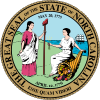|
United States of America
Franklin Mint’s States of The Union – North Carolina
1969 Proof Silver Medal 32mm (14.12 grams) 0.925 Silver
NORTH CAROLINA THE TARHEEL STATE RALEIGH *, Citizen working over state map outline.
NORTH CAROLINA DOGWOOD NORTH CAROLINA ATTAINED STATEHOOD NOVEMBER 21, 1789 12TH STATE, Wreath with banner below, state plant in double circle with stars atop.
You are bidding on the exact item pictured, provided with a Certificate of Authenticity and Lifetime Guarantee of Authenticity.
 
North Carolina is a state in the Southeastern region of the United States. The state is the 28th largest and 9th-most populous of the 50 United States. It is bordered by Virginia to the north, the Atlantic Ocean to the east, Georgia and South Carolina to the south, and Tennessee to the west. Raleigh is the state’s capital and Charlotte is its largest city. The Charlotte metropolitan area, with a population of 2,595,027 in 2020, is the most-populous metropolitan area in North Carolina, the 21st-most populous in the United States, and the largest banking center in the nation after New York City. The Raleigh-Durham-Cary combined statistical area is the second-largest metropolitan area in the state and 32nd-most populous in the United States, with a population of 2,043,867 in 2020, and is home to the largest research park in the United States, Research Triangle Park.
The earliest evidence of human occupation in North Carolina dates back 10,000 years, found at the Hardaway Site. North Carolina was inhabited by Carolina Algonquian, Iroquoian, and Siouan speaking tribes of Native Americans prior to the arrival of Europeans. North Carolina was established as a royal colony in 1729 and was one of the Thirteen Colonies. North Carolina is named in honor of King Charles I of England who first formed the English colony, Carolus being Latin for “Charles”. In 1755 colonial North Carolina received its first postmaster, James Davis, appointed by Benjamin Franklin. The Halifax Resolves resolution adopted by North Carolina on April 12, 1776, was the first formal call for independence from Great Britain among the American Colonies during the American Revolution.
On November 21, 1789, North Carolina became the 12th state to ratify the United States constitution. In the run-up to the American Civil War, North Carolina declared its secession from the Union on May 20, 1861, becoming the tenth of eleven states to join the Confederate States of America. Following the Civil War, the state was restored to the Union on July 4, 1868. On December 17, 1903, Orville and Wilbur Wright successfully piloted the world’s first controlled, sustained flight of a powered, heavier-than-air aircraft at Kitty Hawk in North Carolina’s Outer Banks. North Carolina uses the slogan “First in Flight” on state license plates to commemorate this achievement, alongside a newer alternative design bearing the slogan “First in Freedom” in reference to the Mecklenburg Declaration and Halifax Resolves.
North Carolina is defined by a wide range of elevations and landscapes. From west to east, North Carolina’s elevation descends from the Appalachian Mountains to the Piedmont and Atlantic coastal plain. North Carolina’s Mount Mitchell at 6,684 feet (2,037 m) is the highest point in North America east of the Mississippi River. Most of the state falls in the humid subtropical climate zone; however, the western, mountainous part of the state has a subtropical highland climate.
|












